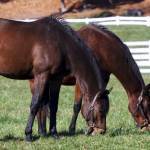Recurrent Colic in Horses

Colic, loosely defined as abdominal pain from any cause, is very common in horses. Impaction, overproduction of intestinal gas, infection, hindgut acidosis, twists, and displacement of the colon are frequently found as causes.
Most horses that suffer a bout of colic will recover, often without veterinary treatment, and go on for years without a return of the condition. However, a smaller number of horses develop signs of colic again and again, sometimes seemingly related to weather changes or some other factor. Finding and eliminating the cause of these episodes is often difficult and frustrating for owners and caregivers.
The veterinary examination of a horse with recurrent colic can involve a number of procedures, usually beginning with obvious things like a check of dental condition, analysis of blood and feces, and rectal palpation. A detailed history of the horse’s exercise program and feeding plan may indicate the need for changes in management. Endoscopic examination of the esophagus and stomach may show the presence of gastric ulcers that are often found in performance horses, with indications of mild colic being one of the typical signs.
Abdominal discomfort can be related to organs apart from those in the digestive system, and a more extensive examination can detect problems with the heart, lungs, or liver. Ultrasound can be used to show tumors, enteroliths, sand accumulation, and unusual thickening of the intestinal walls. Exploratory abdominal surgery to find a cause of recurrent colic is not done without some risks to the horse, and this procedure may or may not locate a specific cause that can be treated.
Treatment of recurrent colic depends on the factors related to the horse’s discomfort. In cases where no obvious cause is identified, management changes may be helpful. These include being sure the horse always has access to clean water; maximizing turnout time; and basing the diet on good-quality forage, with grain added only if it is necessary to support the energy demands of intense exercise.








